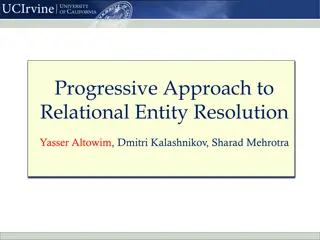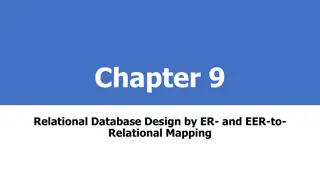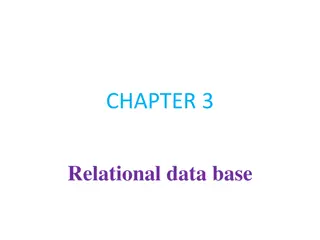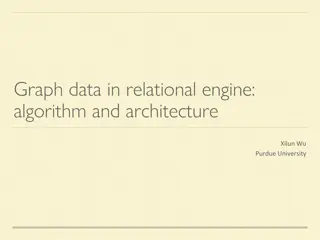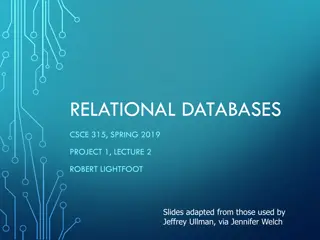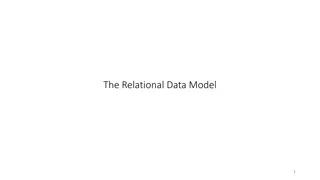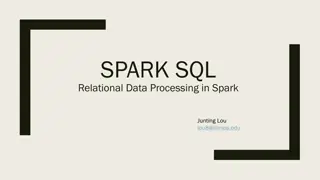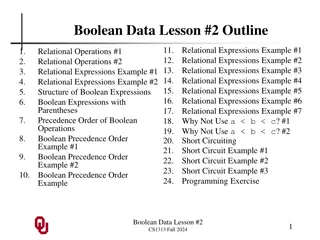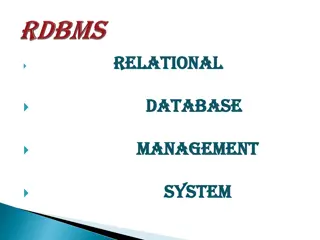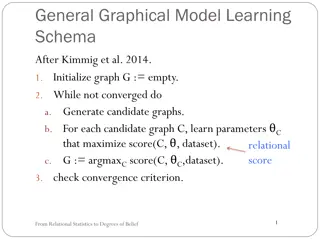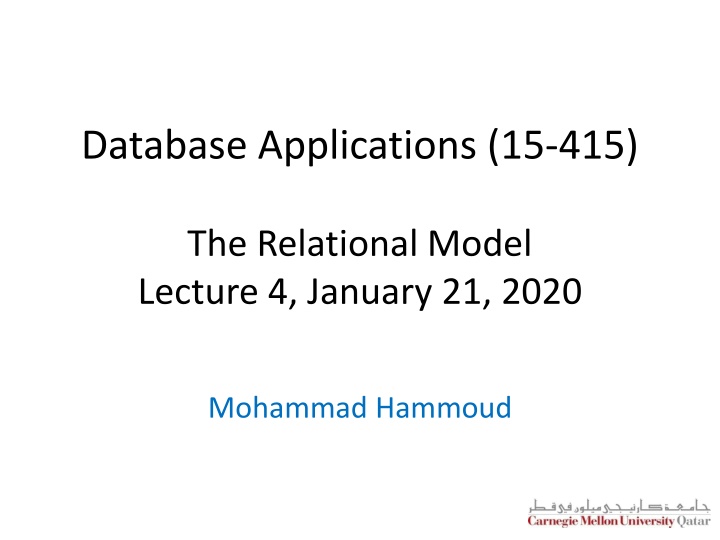
The Relational Model in Database Applications
Explore the fundamentals of the relational model, including its tabular representation, key constructs, domain constraints, and relevance in modern database systems. Discover how the relational model simplifies data representation and enables efficient query execution in relational databases.
Download Presentation

Please find below an Image/Link to download the presentation.
The content on the website is provided AS IS for your information and personal use only. It may not be sold, licensed, or shared on other websites without obtaining consent from the author. If you encounter any issues during the download, it is possible that the publisher has removed the file from their server.
You are allowed to download the files provided on this website for personal or commercial use, subject to the condition that they are used lawfully. All files are the property of their respective owners.
The content on the website is provided AS IS for your information and personal use only. It may not be sold, licensed, or shared on other websites without obtaining consent from the author.
E N D
Presentation Transcript
Database Applications (15-415) The Relational Model Lecture 4, January 21, 2020 Mohammad Hammoud
Today Last Session: The ER model Today s Session: The relational model Basic SQL ER to relational databases Announcements: PS1 is due on Sunday, January 26 by midnight In this week s recitation we will practice on translating ER designs into relational databases
Outline ER Model: Conceptual Design Choices and Summary The Relational Model: Introduction The Relational Model: Basic SQL
Why Studying the Relational Model? Most widely used model Vendors: IBM/Informix, Microsoft, Oracle, Sybase, etc. Legacy systems in older models E.g., IBM s IMS Object-Oriented concepts have merged into An object-relational model Informix->IBM DB2, Oracle 8i
What is the Relational Model? The relational model adopts a tabular representation A database is a collection of one or more relations Each relation is a table with rows and columns What is unique about the relational model as opposed to older data models? Its simple data representation Ease with which complex queries can be expressed
Basic Constructs The main construct in the relational model is the relation A relation consists of: 1. A schema which includes: The relation s name The name of each column The domain of each column 2. An instance which is a set of tuples Each tuple has the same number of columns as the relation schema
The Domain Constraints A relation schema specifies the domain of each column which entails domain constraints A domain constraint specifies a condition by which each instance of a relation should satisfy The values that appear in a column must be drawn from the domain associated with that column Who defines a domain constraint? DBA Who enforces a domain constraint? DBMS
More Details on the Relational Model Degree (or arity) = # of fields sid 53666 Jones jones@cs 53688 Smith smith@eecs 53650 Smith smith@math name login age gpa 18 18 19 3.4 3.2 3.8 Cardinality = # of tuples An instance of the Students relation What is the relational database schema (not the relation schema)? A collection of schemas for the relations in the database What is the instance of a relational database (not the instance of a relation)? A collection of relation instances
Outline The Relational Model: Basic SQL Translating ER Diagrams to Tables and Summary Query Languages
Creating Relations in SQL S1 can be used to create the Students relation S2 can be used to create the Enrolled relation CREATE TABLE Students (sid: CHAR(20), name: CHAR(20), login: CHAR(10), age: INTEGER, gpa: REAL) CREATE TABLE Enrolled (sid: CHAR(20), cid: CHAR(20), grade: CHAR(2)) S2 S1 The DBMS enforces domain constraints whenever tuples are added or modified
Adding and Deleting Tuples We can insert a single tuple to the Students relation using: INSERT INTO Students (sid, name, login, age, gpa) VALUES(53688, Smith , smith@ee , 18, 3.2) We can delete all tuples from the Students relation which satisfy some condition (e.g., name = Smith): DELETE FROM Students S WHERES.name = Smith Powerful variants of these commands are available; more on this next week!
Querying a Relation How can we find all 18-year old students? sid 53666 Jones 53688 Smith smith@eecs 53650 Smith smith@math name login age 18 18 19 gpa 3.4 3.2 3.8 jones@cs SELECT * FROM Students S WHERE S.age=18 sid 53666 53688 name Jones Smith login jones@cs smith@ee age gpa 18 18 3.4 3.2 How can we find just names and logins? SELECT S.name, S.login FROM Students S WHERE S.age=18
Querying Multiple Relations What does the following query compute assuming S and E? SELECT S.name, E.cid FROM Students S, Enrolled E WHERE S.sid=E.sid AND E.grade= A sid cid grade C B A B sid 53666 Jones jones@cs 53688 Smith smith@eecs 53650 Smith smith@math name login age 18 18 19 gpa 3.4 3.2 3.8 53831 Carnatic101 53831 Reggae203 53650 Topology112 53666 History105 E S S.name Smith E.cid Topology112 We get:
Destroying and Altering Relations How to destroy the relation Students ? DROP TABLE Students The schema information and the tuples are deleted How to alter the schema of Students in order to add a new field? ALTER TABLE Students ADD COLUMN firstYear: integer Every tuple in the current instance is extended with a null value in the new field!
Integrity Constraints (ICs) An IC is a condition that must be true for any instance of the database (e.g., domain constraints) ICs are specified when schemas are defined ICs are checked when relations are modified A legal instance of a relation is one that satisfies all specified ICs DBMS should not allow illegal instances If the DBMS checks ICs, stored data is more faithful to real-world meaning Avoids data entry errors, too!
Keys Keys help associate tuples in different relations Keys are one form of integrity constraints (ICs) Enrolled Students sid 53666 15-101 53666 18-203 53650 15-112 53666 15-105 cid grade C B A B sid 53666 Jones jones@cs 53688 Smith smith@cs 53650 Smith smith@math name login age gpa 18 18 19 3.4 3.2 3.8
Keys Keys help associate tuples in different relations Keys are one form of integrity constraints (ICs) Enrolled Students sid 53666 15-101 53666 18-203 53650 15-112 53666 15-105 cid grade C B A B sid 53666 Jones jones@cs 53688 Smith smith@cs 53650 Smith smith@math name login age gpa 18 18 19 3.4 3.2 3.8 FOREIGN Key PRIMARY Key
Superkey, Primary and Candidate Keys A set of fields is a superkey if: No two distinct tuples can have same values in all key fields A set of fields is a primary key for a relation if: It is a minimal superkey What if there is more than one key for a relation? One of the keys is chosen (by DBA) to be the primary key Other keys are called candidate keys Examples: sid is a key for Students (what about name?) The set {sid, name} is a superkey (or a set of fields that contains a key)
Primary and Candidate Keys in SQL Many candidate keys (specified using UNIQUE) can be designated and one is chosen as a primary key Keys must be used carefully! For a given student and course, there is a single grade
Primary and Candidate Keys in SQL Many candidate keys (specified using UNIQUE) can be designated and one is chosen as a primary key Keys must be used carefully! For a given student and course, there is a single grade CREATE TABLE Enrolled (sid CHAR(20) cid CHAR(20), grade CHAR(2), PRIMARY KEY (sid), UNIQUE (cid, grade)) CREATE TABLE Enrolled (sid CHAR(20) cid CHAR(20), grade CHAR(2), PRIMARY KEY (sid,cid)) vs.
Primary and Candidate Keys in SQL Many candidate keys (specified using UNIQUE) can be designated and one is chosen as a primary key Keys must be used carefully! For a given student and course, there is a single grade CREATE TABLE Enrolled (sid CHAR(20) cid CHAR(20), grade CHAR(2), PRIMARY KEY (sid), UNIQUE (cid, grade)) CREATE TABLE Enrolled (sid CHAR(20) cid CHAR(20), grade CHAR(2), PRIMARY KEY (sid,cid)) vs. Q: What does this mean?
Primary and Candidate Keys in SQL Many candidate keys (specified using UNIQUE) can be designated and one is chosen as a primary key Keys must be used carefully! For a given student and course, there is a single grade CREATE TABLE Enrolled (sid CHAR(20) cid CHAR(20), grade CHAR(2), PRIMARY KEY (sid), UNIQUE (cid, grade)) CREATE TABLE Enrolled (sid CHAR(20) cid CHAR(20), grade CHAR(2), PRIMARY KEY (sid,cid)) vs. A student can take only one course, and no two students in a course receive the same grade
Foreign Keys and Referential Integrity A foreign key is a set of fields referring to a tuple in another relation It must correspond to the primary key of the other relation It acts like a `logical pointer If all foreign key constraints are enforced, referential integrity is said to be achieved (i.e., no dangling references)
Foreign Keys in SQL Example: Only existing students may enroll for courses sid is a foreign key referring to Students How can we write this in SQL? Enrolled Students sid 53666 15-101 53666 18-203 53650 15-112 53666 15-105 cid grade C B A B sid 53666 Jones jones@cs 53688 Smith smith@cs 53650 Smith smith@math name login age gpa 18 18 19 3.4 3.2 3.8
Foreign Keys in SQL Example: Only existing students may enroll for courses CREATE TABLE Enrolled (sid CHAR(20),cid CHAR(20),grade CHAR(2), PRIMARY KEY (sid,cid), FOREIGN KEY (sid) REFERENCES Students ) Enrolled Students sid 53666 15-101 53666 18-203 53650 15-112 53666 15-105 cid grade C B A B sid 53666 Jones jones@cs 53688 Smith smith@cs 53650 Smith smith@math name login age gpa 18 18 19 3.4 3.2 3.8
Enforcing Referential Integrity What should be done if an Enrolled tuple with a non- existent student id is inserted? (Reject it!) What should be done if a Students tuple is deleted? Disallow its deletion Delete all Enrolled tuples that refer to it Set sid in Enrolled tuples that refer to it to a default sid Set sid in Enrolled tuples that refer to it to a special value null, denoting `unknown or `inapplicable What if a Students tuple is updated?
Referential Integrity in SQL SQL/92 and SQL:1999 support all 4 options on deletes and updates Default is NO ACTION (i.e., delete/update is rejected) CASCADE (also delete all tuples that refer to the deleted tuple) SET NULL / SET DEFAULT (sets foreign key value of referencing tuple) CREATE TABLE Enrolled (sid CHAR(20), cid CHAR(20), grade CHAR(2), PRIMARY KEY (sid,cid), FOREIGN KEY (sid) REFERENCES Students ON DELETE CASCADE ON UPDATE SET DEFAULT ) What does this mean?
Where do ICs Come From? ICs are based upon the semantics of the real-world enterprise that is being described in the database relations We can check a database instance to see if an IC is violated, but we can NEVER infer that an IC is true by looking at an instance An IC is a statement about all possible instances! From the Students relation, we know name is not a key, but the assertion that sid is a key is given to us Key and foreign key ICs are the most common; more general ICs are supported too
Views A view is a table whose rows are not explicitly stored but computed as needed CREATE VIEW YoungActiveStudents (name, grade) AS SELECT S.name, E.grade FROM Students S, Enrolled E WHERE S.sid = E.sid and S.age<21 Views can be queried Querying YoungActiveStudents would necessitate computing it first then applying the query on the result as being like any other relation Views can be dropped using the DROP VIEW command How to handle DROP TABLE if there s a view on the table? DROP TABLE command has options to let the user specify this
Views and Security Views can be used to present necessary information, while hiding details in underlying relation(s) If the schema of an old relation is changed, a view can be defined to represent the old schema This allows applications to transparently assume the old schema Views can be defined to give a group of users access to just the information they are allowed to see E.g., we can define a view that allows students to see other students names and ages, but not GPAs (also students can be prevented from accessing the underlying Students relation)
Views and Security Views can be used to present necessary information, while hiding details in underlying relation(s) If the schema of an old relation is changed, a view can be defined to represent the old schema This allows applications to transparently assume the old schema Logical Data Independence! Views can be defined to give a group of users access to just the information they are allowed to see E.g., we can define a view that allows students to see other students names and ages, but not GPAs (also students can be prevented from accessing the underlying Students relation)
Views and Security Views can be used to present necessary information, while hiding details in underlying relation(s) If the schema of an old relation is changed, a view can be defined to represent the old schema This allows applications to transparently assume the old schema Logical Data Independence! Views can be defined to give a group of users access to just the information they are allowed to see E.g., we can define a view that allows students to see other students names and ages, but not GPAs (also students can be prevented from accessing the underlying Students relation) Security!
Outline The Relational Model: Basic SQL Translating ER Diagrams to Tables and Summary Query Languages
Strong Entity Sets to Tables CREATE TABLE Employees (ssn CHAR(11), name CHAR(20), lot INTEGER, PRIMARY KEY (ssn)) name ssn lot Employees
Relationship Sets to Tables In translating a relationship set to a relation, attributes of the relation must include: Keys for each participating entity set (as foreign keys) This set of attributes forms a superkey for the relation 1. All descriptive attributes 2. Relationship sets 1-to-1, 1-to-many, and many-to-many Key/Total/Partial participation
M-to-N Relationship Sets to Tables since name dname budget ssn lot did Employees Works_In Departments CREATE TABLE Works_In( ssn CHAR(11), did INTEGER, since DATE, PRIMARY KEY (ssn, did), FOREIGN KEY (ssn) REFERENCES Employees, FOREIGN KEY (did) REFERENCES Departments)
1-to-M Relationship Sets to Tables since name dname budget ssn lot did Employees Manages Departments CREATE TABLE Manages( ssn CHAR(11), did INTEGER, since DATE, PRIMARY KEY (did), FOREIGN KEY (ssn) REFERENCES Employees, FOREIGN KEY (did) REFERENCES Departments) CREATE TABLE Departments( did INTEGER), dname CHAR(20), budget REAL, PRIMARY KEY (did), ) Approach 1: Create separate tables for Manages and Departments
1-to-M Relationship Sets to Tables since name dname budget ssn lot did Employees Manages Departments CREATE TABLE Dept_Mgr( ssn CHAR(11), did INTEGER, since DATE, dname CHAR(20), budget REAL, PRIMARY KEY (did), FOREIGN KEY (ssn) REFERENCES Employees) Can ssn take a null value? Approach 2: Create a table for only the Departments entity set (i.e., take advantage of the key constraint)
One-Table vs. Two-Table Approaches The one-table approach: (+) Eliminates the need for a separate table for the involved relationship set (e.g., Manages) (+) Queries can be answered without combining information from two relations (-) Space could be wasted! What if several departments have no managers? The two-table approach: The opposite of the one-table approach!
Translating Relationship Sets with Participation Constraints What does the following ER diagram entail (with respect to Departments and Managers)? since since name name dname dname ssn did did budget budget lot Departments Employees Manages Works_In since Every did value in Departments table must appear in a row of the Manages table- if defined- (with a non-null ssn value!)
Translating Relationship Sets with Participation Constraints Here is how to create the Dept_Mgr table using the one-table approach: CREATE TABLE Dept_Mgr( did INTEGER, dname CHAR(20), budget REAL, ssn CHAR(11) NOT NULL, since DATE, PRIMARY KEY (did), FOREIGN KEY (ssn) REFERENCES Employees, ON DELETE NO ACTION) Can this be captured using the two-table approach?
Translating Relationship Sets with Participation Constraints Here is how to create the Dept_Mgr table using the one-table approach: CREATE TABLE Dept_Mgr( did INTEGER, dname CHAR(20), budget REAL, ssn CHAR(11) NOT NULL, since DATE, PRIMARY KEY (did), FOREIGN KEY (ssn) REFERENCES Employees, ON DELETE SET NULL) Would this work?
Translating Weak Entity Sets A weak entity set always: Participates in a one-to-many binary relationship Has a key constraint and total participation name cost dname age ssn lot Policy Dependents Employees Which approach is ideal for that? The one-table approach
Translating Weak Entity Sets Here is how to create Dep_Policy using the one-table approach name cost dname age ssn lot Policy Dependents Employees CREATE TABLE Dep_Policy ( dname CHAR(20), age INTEGER, cost REAL, ssn CHAR(11) NOT NULL, PRIMARY KEY (dname, ssn), FOREIGN KEY (ssn) REFERENCES Employees, ON DELETE CASCADE)
Translating ISA Hierarchies to Relations Consider the following example: name ssn lot Employees hours_worked hourly_wages ISA contractid Contract_Emps Hourly_Emps
Translating ISA Hierarchies to Relations name ssn lot General approach: Create 3 relations: Employees , Hourly_Emps and Contract_Emps Employees hourly_wages hours_worked ISA contractid Hourly_Emps Contract_Emps EMP (ssn, name, lot) H_EMP(ssn, h_wg, h_wk) CONTR(ssn, cid) How many times do we record an employee? What to do on deletions? How to retrieve all info about an employee?
Translating ISA Hierarchies to Relations name ssn lot Alternatively: Just create 2 relations Hourly_Emps and Contract_Emps Each employee must be in one of these two subclasses Employees hourly_wages hours_worked ISA contractid Hourly_Emps Contract_Emps EMP (ssn, name, lot) black is gone! H_EMP(ssn, h_wg, h_wk, name, lot) CONTR(ssn, cid, name, lot) Duplicate Values!
Translating Aggregations Consider the following example: name ssn lot Employees Monitors until since started_on dname pid pbudget did budget Sponsors Departments Projects
Translating Aggregations Standard approach: The Employees, Projects and Departments entity sets and the Sponsors relationship sets are translated as described previously name ssn lot Employees Monitors until For the Monitors relationship, we create a relation with the following attributes: The key attribute of Employees (i.e., ssn) The key attributes of Sponsors (i.e., did, pid) The descriptive attributes of Monitors (i.e., until) since started_on dname pid pbudget did budget Sponsors Departments Projects
The Relational Model: A Summary A tabular representation of data Simple and intuitive, currently one of the most widely used Object-Relational Mapping (ORM) hides the relational model Non-relational NoSQL model is gaining ground Integrity constraints can be specified (by the DBA) based on application semantics (DBMS checks for violations) Two important ICs: primary and foreign keys Also: not null, unique In addition, we always have domain constraints Mapping from ER to Relational is (fairly) straightforward!

